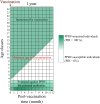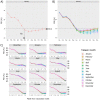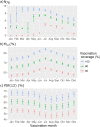Modelling the Dynamics of Post-Vaccination Immunity Rate in a Population of Sahelian Sheep after a Vaccination Campaign against Peste des Petits Ruminants Virus
- PMID: 27603710
- PMCID: PMC5014330
- DOI: 10.1371/journal.pone.0161769
Modelling the Dynamics of Post-Vaccination Immunity Rate in a Population of Sahelian Sheep after a Vaccination Campaign against Peste des Petits Ruminants Virus
Abstract
Background: Peste des petits ruminants (PPR) is an acute infectious viral disease affecting domestic small ruminants (sheep and goats) and some wild ruminant species in Africa, the Middle East and Asia. A global PPR control strategy based on mass vaccination-in regions where PPR is endemic-was recently designed and launched by international organizations. Sahelian Africa is one of the most challenging endemic regions for PPR control. Indeed, strong seasonal and annual variations in mating, mortality and offtake rates result in a complex population dynamics which might in turn alter the population post-vaccination immunity rate (PIR), and thus be important to consider for the implementation of vaccination campaigns.
Methods: In a context of preventive vaccination in epidemiological units without PPR virus transmission, we developed a predictive, dynamic model based on a seasonal matrix population model to simulate PIR dynamics. This model was mostly calibrated with demographic and epidemiological parameters estimated from a long-term follow-up survey of small ruminant herds. We used it to simulate the PIR dynamics following a single PPR vaccination campaign in a Sahelian sheep population, and to assess the effects of (i) changes in offtake rate related to the Tabaski (a Muslim feast following the lunar calendar), and (ii) the date of implementation of the vaccination campaigns.
Results: The persistence of PIR was not influenced by the Tabaski date. Decreasing the vaccination coverage from 100 to 80% had limited effects on PIR. However, lower vaccination coverage did not provide sufficient immunity rates (PIR < 70%). As a trade-off between model predictions and other considerations like animal physiological status, and suitability for livestock farmers, we would suggest to implement vaccination campaigns in September-October. This model is a first step towards better decision support for animal health authorities. It might be adapted to other species, livestock farming systems or diseases.
Conflict of interest statement
The authors have declared that no competing interests exist.
Figures









Similar articles
-
Evaluation of effectiveness of Mass Vaccination Campaign against Peste des petits ruminants in Chhattisgarh state, India.Transbound Emerg Dis. 2019 May;66(3):1349-1359. doi: 10.1111/tbed.13163. Epub 2019 Mar 28. Transbound Emerg Dis. 2019. PMID: 30839170
-
Ex-ante assessment of different vaccination-based control schedules against the peste des petits ruminants virus in sub-Saharan Africa.PLoS One. 2018 Jan 19;13(1):e0190296. doi: 10.1371/journal.pone.0190296. eCollection 2018. PLoS One. 2018. PMID: 29351277 Free PMC article.
-
Specific detection of peste des petits ruminants virus antibodies in sheep and goat sera by the luciferase immunoprecipitation system.J Virol Methods. 2016 Jan;227:40-6. doi: 10.1016/j.jviromet.2015.10.008. Epub 2015 Oct 23. J Virol Methods. 2016. PMID: 26506137
-
Peste des Petits Ruminants, the next eradicated animal disease?Vet Microbiol. 2013 Jul 26;165(1-2):38-44. doi: 10.1016/j.vetmic.2012.12.013. Epub 2012 Dec 22. Vet Microbiol. 2013. PMID: 23313537 Review.
-
Vaccines against peste des petits ruminants virus.Expert Rev Vaccines. 2010 Jul;9(7):785-96. doi: 10.1586/erv.10.74. Expert Rev Vaccines. 2010. PMID: 20624051 Review.
Cited by
-
Predictive gravity models of livestock mobility in Mauritania: The effects of supply, demand and cultural factors.PLoS One. 2018 Jul 18;13(7):e0199547. doi: 10.1371/journal.pone.0199547. eCollection 2018. PLoS One. 2018. PMID: 30020968 Free PMC article.
-
Towards the description of livestock mobility in Sahelian Africa: Some results from a survey in Mauritania.PLoS One. 2018 Jan 24;13(1):e0191565. doi: 10.1371/journal.pone.0191565. eCollection 2018. PLoS One. 2018. PMID: 29364989 Free PMC article.
-
Prioritizing smallholder animal health needs in East Africa, West Africa, and South Asia using three approaches: Literature review, expert workshops, and practitioner surveys.Prev Vet Med. 2021 Apr;189:105279. doi: 10.1016/j.prevetmed.2021.105279. Epub 2021 Jan 27. Prev Vet Med. 2021. PMID: 33581421 Free PMC article.
-
Strategies for the Global Eradication of Peste des Petits Ruminants: An Argument for the Use of Guerrilla Rather Than Trench Warfare.Front Vet Sci. 2019 Sep 26;6:331. doi: 10.3389/fvets.2019.00331. eCollection 2019. Front Vet Sci. 2019. PMID: 31612143 Free PMC article.
-
PPR Control in a Sahelian Setting: What Vaccination Strategy for Mauritania?Front Vet Sci. 2019 Jul 23;6:242. doi: 10.3389/fvets.2019.00242. eCollection 2019. Front Vet Sci. 2019. PMID: 31396525 Free PMC article.
References
-
- Stem C. An economic analysis of the prevention of peste des petits ruminants in Nigerien goats. Preventive Veterinary Medicine. 1993;16(2):141–150. 10.1016/0167-5877(93)90084-7 - DOI
-
- Thombare N, Sinha MK. Economic Implications of Peste des petits ruminants (PPR) Disease in Sheep and Goats: A Sample Analysis of District Pune, Maharastra1. Agricultural Economics Research Review. 2009;22(2):319–322.
-
- Kihu SM, Gitao GC, Bebora LC, John NM, Wairire GG, Maingi N, et al. Economic losses associated with Peste des petits ruminants in Turkana County Kenya. Pastoralism. 2015;5(1):1–8. 10.1186/s13570-015-0029-6 - DOI
MeSH terms
LinkOut - more resources
Full Text Sources
Other Literature Sources
Medical
Research Materials

